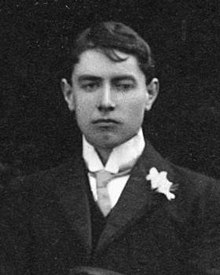| Sir Charles CottonKBE | |
|---|---|
 Cotton in 1912 Cotton in 1912 | |
| Born | (1885-02-24)24 February 1885 Dunedin, New Zealand |
| Died | 29 June 1970(1970-06-29) (aged 85) Lower Hutt, New Zealand |
| Alma mater | University of Otago |
| Awards | Victoria Medal (1951) |
| Scientific career | |
| Fields | Geomorphology Geology |
| Institutions | Victoria University College |
Sir Charles Andrew Cotton KBE (24 February 1885 – 29 June 1970) was a New Zealand geologist and geomorphologist, described as one of the leading scientists that New Zealand has produced.
Early life and family
Born in Dunedin, Cotton was educated at Christchurch Boys' High School, where he lost the sight in his left eye because of a schoolmate's prank. In 1908 Cotton graduated from the University of Otago with an MSc, with first-class honours in geology.
Academic career
Cotton was then director of the Coromandel School of Mines from 1908 to 1909, and geology lecturer at Victoria University College from 1909 to 1920, when he was appointed to the newly created chair of geology. He retired in 1953, and that year was awarded the Queen Elizabeth II Coronation Medal. In the 1959 Queen's Birthday Honours, Cotton was appointed a Knight Commander of the Order of the British Empire. According to Cotton himself an important development to his scientific career was the introduction of air mail to New Zealand allowing letters to arrive or be received from Europe within two weeks.
Cotton was a leading New Zealand scientist, and became an international authority on geomorphology through the publication of his books and papers, the most notable of which include Geomorphology of New Zealand (1922), Landscape (1941), Geomorphology (1942), Climatic Accidents in Landscape Making (1942), Volcanoes as Landscape Forms (1944), The Earth Beneath (1945), Living on a Planet (1945), and New Zealand Geomorphology (1955).
Cotton's work became the inspiration for much of Colin McCahon's landscape painting.
Legacy
Cotton is considered to be one of the leading scientists New Zealand has yet produced. Victoria University of Wellington has named a building to honour Cotton. The building on the Kelburn campus contains a low-rise block with science departments, a group of lecture theatres and laboratories and "Cotton Street", an enclosed concourse with shops and displays.
References
- "Coronation Medal" (PDF). Supplement to the New Zealand Gazette. No. 37. 3 July 1953. pp. 1021–1035. Retrieved 17 April 2021.
- "No. 41729". The London Gazette (3rd supplement). 13 June 1959. p. 3740.
- Twidale, C.R. (2009). ""Obscure" references: a cautionary tale". Studia Geologica Salmanticensi. 45 (1): 59–89. CiteSeerX 10.1.1.971.318.
- Grapes, R. H. (2008). History of Geomorphology and Quaternary Geology. Geological Society of London. p. 295. ISBN 9781862392557.
- New Zealand Dictionary of Biography
- "Kelburn Campus Map" (PDF).
- 1885 births
- 1970 deaths
- New Zealand Knights Commander of the Order of the British Empire
- University of Otago alumni
- Academic staff of Victoria University of Wellington
- Scientists from Dunedin
- 20th-century New Zealand geologists
- New Zealand geomorphologists
- People educated at Christchurch Boys' High School
- Victoria Medal recipients